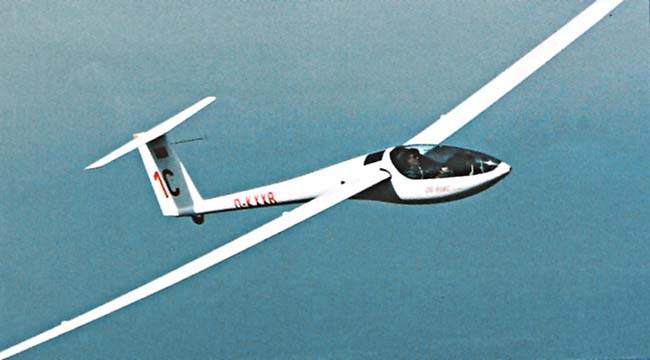A report from Gerhard Marzinzik in Aerokurier 11/2005
The DG808S showed the way and now the self launcher’s following.
In good conditions there’s the accelerator :
The ability to fly with a wing loading of 50+
The motor glider now goes by the name of DG-808C Competition. A complete overhaul of the electrical system together with the increased wing loading have brought about the new label, but is the new name really justified?
With it’s 18m wingspan the DG can now take off with a maximum of 600kg (50.8 kg/sqm). The outer wings have been reinforced to take this high flying weight. The DG-808C Competition is structurally identical to the DG-808S. In contrast to the s version with it’s four compartment water tank however the C-Competition comes with two 75 litre water bags. In comparison to the B model the bags are set further out in the wings.
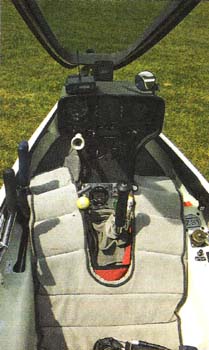 The weight increase has also bestowed a 7.5 litre tail tank on the motor glider for the first time. This enables the centre of gravity to be moved and handling difficulties caused by ballasting to be corrected.
The weight increase has also bestowed a 7.5 litre tail tank on the motor glider for the first time. This enables the centre of gravity to be moved and handling difficulties caused by ballasting to be corrected.
The undercarriage has been beefed up. The suspension travel has grown by a third. The long stringer reinforced safety cockpit is now standard equipment. For the C Competition, the bug wiper garages in the wing fuse transition area now also count as series production equipment.
Roomy, tidy cockpit despite reinforcement for crash survivability and
emergency exit assistance system NOAH in the seat pan.
What’s totally new in the C version is the electrics. In the instrument panel there’s the DEI-NT (Digital Engine Indicator- New Technology) including the new stall warning. The controller almost completely automates the deployment and shutting down of the engine, but still allows the pilot complete freedom to take control in case of a possible malfunction. The graphics (now integrated) give precise information about all engine parameters.
The options list also contains new winglets for the 15m wing span version and an ergonomically optimized pedal adjustment, which significantly improves the comfort level for shorter pilots – they no longer need to embrace the instrument panel in a bow legged manner.
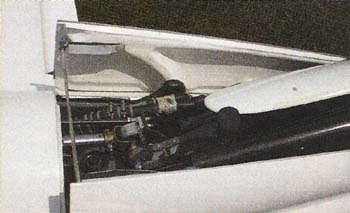 The DG-808C Competition supplied for this pilot report was fitted with the likewise optionally available BBSA friction clutch. This clutch softens the peak loads which the drive belt is subjected to when starting on the ground. In (so far) rare cases (at least in DG systems according to Chief Design Engineer Wilhelm Dirks) these peak loads have led to the belt being destroyed. When starting in flight, such peak loads don’t occur as the propeller is set in motion by the apparent wind. The friction clutch on the other hand rules out the automatic propeller brake, instead the otherwise customary propeller stopper comes back into service.
The DG-808C Competition supplied for this pilot report was fitted with the likewise optionally available BBSA friction clutch. This clutch softens the peak loads which the drive belt is subjected to when starting on the ground. In (so far) rare cases (at least in DG systems according to Chief Design Engineer Wilhelm Dirks) these peak loads have led to the belt being destroyed. When starting in flight, such peak loads don’t occur as the propeller is set in motion by the apparent wind. The friction clutch on the other hand rules out the automatic propeller brake, instead the otherwise customary propeller stopper comes back into service.
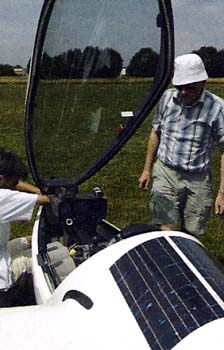 For the test flight in Bruchsal, the Competition was filled up to the gunwales (read to a maximum flying weight of 600 kg) for me. Five litres in the tail tank shifts the centre of gravity into the rear third.
For the test flight in Bruchsal, the Competition was filled up to the gunwales (read to a maximum flying weight of 600 kg) for me. Five litres in the tail tank shifts the centre of gravity into the rear third.
 The first surprise comes right at the start. From the rigging position I’m rolling the 18 metre aeroplane along the grass runway, wing down on the little wing wheel, and steering with the steerable tail wheel. The flaps are already set in the +8 degree position for optimum climb. Still mulling over the idea that, with around 70 litres of water in the laid down wing it might actually be better to start the take off roll with negative flap in order to facilitate earlier aileron effectiveness, and the Competition has happily started responding. It still takes a while until the wing lifts itself despite full aileron, but everything makes a reassuring impression. No tendency to branch off shows itself. Changing flap settings in this phase of the flight and thereby incurring the risk of possible loss of directional control is not necessary even with a 50+ wing loading. Halfway down the runway the Competition has lifted itself out of the grass and is climbing at a satisfying 7 knots. It seems quite as if the engine simply doesn’t notice the additional mass.
The first surprise comes right at the start. From the rigging position I’m rolling the 18 metre aeroplane along the grass runway, wing down on the little wing wheel, and steering with the steerable tail wheel. The flaps are already set in the +8 degree position for optimum climb. Still mulling over the idea that, with around 70 litres of water in the laid down wing it might actually be better to start the take off roll with negative flap in order to facilitate earlier aileron effectiveness, and the Competition has happily started responding. It still takes a while until the wing lifts itself despite full aileron, but everything makes a reassuring impression. No tendency to branch off shows itself. Changing flap settings in this phase of the flight and thereby incurring the risk of possible loss of directional control is not necessary even with a 50+ wing loading. Halfway down the runway the Competition has lifted itself out of the grass and is climbing at a satisfying 7 knots. It seems quite as if the engine simply doesn’t notice the additional mass.
Meanwhile the DEI-NT is delivering the most important motor data. The best climb rate is achieved at 49 knots (still significantly above the stall speed).
The transition to sailplane configuration is successfully achieved in DG typical comfort. It’s almost done just by shutting off the ignition. Only setting the propeller vertical (after it’s been stopped and the propeller column has been swung back a stage) demands further attention. A press on the starter, or alternatively lowering the nose a little, drives the propeller against the stopper. Overview is provided either by the small rear view mirror on the Instrument pod or the graphics in the DEI-NT.
The control column remains a true joy stick at all wing loadings.
I’m feeling my way in the blue in good lift over the vast forested area north west of Bruchsal. Everything from here on in comes naturally. Hooking in and climbing away just as if the 150 litres of water simply weren’t on board.
The Competition agilely follows commands from the wrist and just about turns on a penny. A little bit of centering correction and the DG is soon steadily circling in the centre of lift. Not a sign of increased control forces. The optimization of the C of G leaves the stick in a comfortable middle position even at high angles of bank. Pitch corrections can therefore be finely controlled in the linear range of the elevator.
Second Surprise: Every square metre of wing has to carry 50.8kg, but the impression of sitting in a slovenly unruly tanker doesn’t occur even for a moment.
The stall warning, which in the new DEI is implemented with a type of angle of attack measurement, uses a hooter to let you know it’s there. I found the stick vibration alarm in the DG-1000T suited me better. The tactile indication stands out very clearly from the many acoustic signals and could also manage to get direct access to the pilot in a stressful situation. In the case where the radio, navigation computer with airspace warning, and possibly the FLARM collision warning device as well all conspire to convert the cockpit into a disco, and then the stall warning also goes off – there’s also an acoustic undercarriage warning – the stall warning could easily be swamped in the whole concerto. The stall warning as a vibrating alarm is admittedly offered as an option.
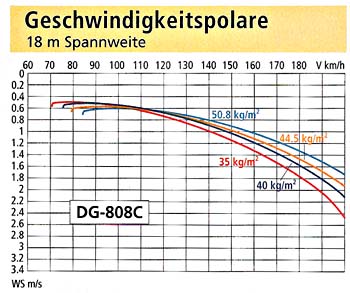 With the 50+ wing loading the horn goes off promptly when circling with about 30 degrees of bank at around 57 knots. You can’t help noticing here that a high wing loading has to come with disadvantages after all. The stall speed with the high wing loading in straight and level flight and with the flaps in the circling position (+8 degrees) is 44 knots. There’s lots of scope to vary the wing loading.
With the 50+ wing loading the horn goes off promptly when circling with about 30 degrees of bank at around 57 knots. You can’t help noticing here that a high wing loading has to come with disadvantages after all. The stall speed with the high wing loading in straight and level flight and with the flaps in the circling position (+8 degrees) is 44 knots. There’s lots of scope to vary the wing loading.
It’s a real joy when you can let the Competition really run at the high wing loading. With a flap setting of -14 degrees and 108 knots indicated, it shoots along with the nose barely under the horizon. The 808C flies on unperturbed, in still air the sink rate at this speed is just on 3.4 knots. It’s just as if the flight were running on horizontally. The landscape changes below.
The only thing which detracts from the good impression is the somewhat notchy flap adjustment mechanism which takes significant effort to operate in the faster flying positions.
To finish off I dispose of the water and let the Competition climb once more, this time with a wing loading of around 38 kg/sqm. Being so much lighter, it’s now very much slower and tighter, just what’s required for weak narrow thermals. As it turns out the loading has no effect on the handling characteristics provided the tail tank is used sensibly. The Competition is very agile in both cases, you can just about “think” it into a turn.
With the extension of the weight limits and the new motor electronics, the DG-808 has clearly had another win. In as much as the higher maximum wing loading is above all of interest to competition pilots, the new name is clearly justified.
Not every 808 fan has to join this competition oriented trend however. There are pilots for whom the high maximum wing loading doesn’t make sense because they’d sooner make use of the whole flying day beginning with weak morning thermals. For them, there’s the DG-808C with a maximum wing loading of 44.5kg/sqm.
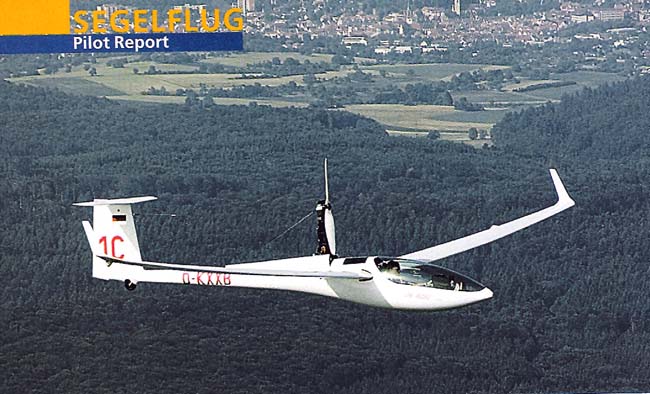
Gerhard Marzinzik – Translation Brendan English, Australia

